Yanming Liu
LLM-OptiRA: LLM-Driven Optimization of Resource Allocation for Non-Convex Problems in Wireless Communications
May 04, 2025Abstract:Solving non-convex resource allocation problems poses significant challenges in wireless communication systems, often beyond the capability of traditional optimization techniques. To address this issue, we propose LLM-OptiRA, the first framework that leverages large language models (LLMs) to automatically detect and transform non-convex components into solvable forms, enabling fully automated resolution of non-convex resource allocation problems in wireless communication systems. LLM-OptiRA not only simplifies problem-solving by reducing reliance on expert knowledge, but also integrates error correction and feasibility validation mechanisms to ensure robustness. Experimental results show that LLM-OptiRA achieves an execution rate of 96% and a success rate of 80% on GPT-4, significantly outperforming baseline approaches in complex optimization tasks across diverse scenarios.
ASMA-Tune: Unlocking LLMs' Assembly Code Comprehension via Structural-Semantic Instruction Tuning
Mar 14, 2025Abstract:Analysis and comprehension of assembly code are crucial in various applications, such as reverse engineering. However, the low information density and lack of explicit syntactic structures in assembly code pose significant challenges. Pioneering approaches with masked language modeling (MLM)-based methods have been limited by facilitating natural language interaction. While recent methods based on decoder-focused large language models (LLMs) have significantly enhanced semantic representation, they still struggle to capture the nuanced and sparse semantics in assembly code. In this paper, we propose Assembly Augmented Tuning (ASMA-Tune), an end-to-end structural-semantic instruction-tuning framework. Our approach synergizes encoder architectures with decoder-based LLMs through projector modules to enable comprehensive code understanding. Experiments show that ASMA-Tune outperforms existing benchmarks, significantly enhancing assembly code comprehension and instruction-following abilities. Our model and dataset are public at https://github.com/wxy3596/ASMA-Tune.
Movable-Antenna Aided Secure Transmission for RIS-ISAC Systems
Oct 04, 2024



Abstract:Integrated sensing and communication (ISAC) systems have the issue of secrecy leakage when using the ISAC waveforms for sensing, thus posing a potential risk for eavesdropping. To address this problem, we propose to employ movable antennas (MAs) and reconfigurable intelligent surface (RIS) to enhance the physical layer security (PLS) performance of ISAC systems, where an eavesdropping target potentially wiretaps the signals transmitted by the base station (BS). To evaluate the synergistic performance gain provided by MAs and RIS, we formulate an optimization problem for maximizing the sum-rate of the users by jointly optimizing the transmit/receive beamformers of the BS, the reflection coefficients of the RIS, and the positions of MAs at communication users, subject to a minimum communication rate requirement for each user, a minimum radar sensing requirement, and a maximum secrecy leakage to the eavesdropping target. To solve this non-convex problem with highly coupled variables, a two-layer penalty-based algorithm is developed by updating the penalty parameter in the outer-layer iterations to achieve a trade-off between the optimality and feasibility of the solution. In the inner-layer iterations, the auxiliary variables are first obtained with semi-closed-form solutions using Lagrange duality. Then, the receive beamformer filter at the BS is optimized by solving a Rayleigh-quotient subproblem. Subsequently, the transmit beamformer matrix is obtained by solving a convex subproblem. Finally, the majorization-minimization (MM) algorithm is employed to optimize the RIS reflection coefficients and the positions of MAs. Extensive simulation results validate the considerable benefits of the proposed MAs-aided RIS-ISAC systems in enhancing security performance compared to traditional fixed position antenna (FPA)-based systems.
Bridging Context Gaps: Leveraging Coreference Resolution for Long Contextual Understanding
Oct 02, 2024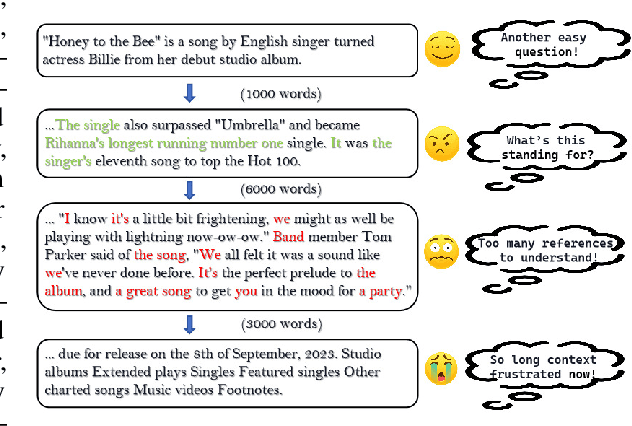
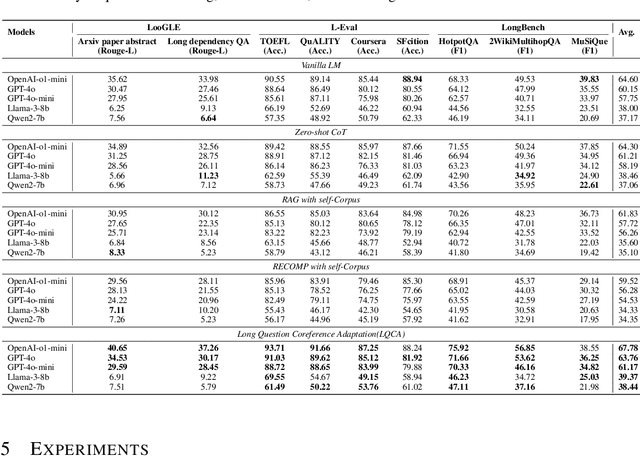
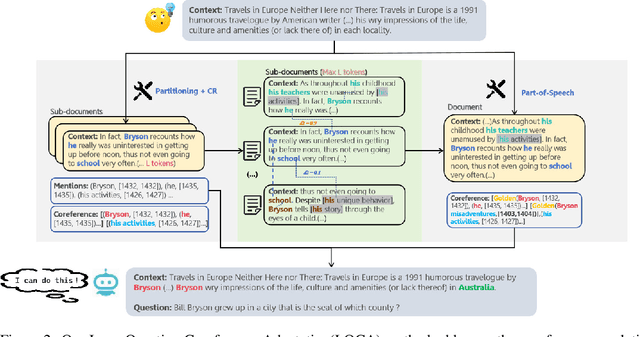

Abstract:Large language models (LLMs) have shown remarkable capabilities in natural language processing; however, they still face difficulties when tasked with understanding lengthy contexts and executing effective question answering. These challenges often arise due to the complexity and ambiguity present in longer texts. To enhance the performance of LLMs in such scenarios, we introduce the Long Question Coreference Adaptation (LQCA) method. This innovative framework focuses on coreference resolution tailored to long contexts, allowing the model to identify and manage references effectively. The LQCA method encompasses four key steps: resolving coreferences within sub-documents, computing the distances between mentions, defining a representative mention for coreference, and answering questions through mention replacement. By processing information systematically, the framework provides easier-to-handle partitions for LLMs, promoting better understanding. Experimental evaluations on a range of LLMs and datasets have yielded positive results, with a notable improvements on OpenAI-o1-mini and GPT-4o models, highlighting the effectiveness of leveraging coreference resolution to bridge context gaps in question answering.
MemDPT: Differential Privacy for Memory Efficient Language Models
Jun 16, 2024


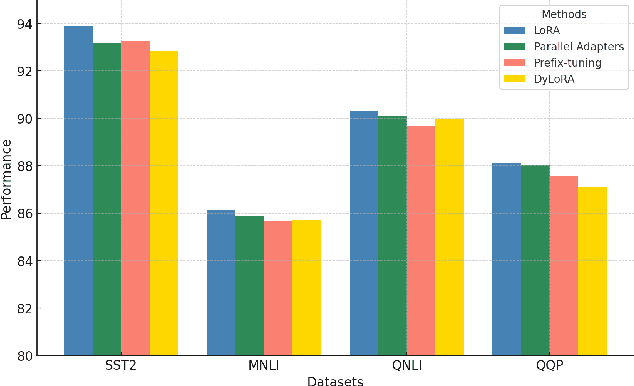
Abstract:Large language models have consistently demonstrated remarkable performance across a wide spectrum of applications. Nonetheless, the deployment of these models can inadvertently expose user privacy to potential risks. The substantial memory demands of these models during training represent a significant resource consumption challenge. The sheer size of these models imposes a considerable burden on memory resources, which is a matter of significant concern in practice. In this paper, we present an innovative training framework MemDPT that not only reduces the memory cost of large language models but also places a strong emphasis on safeguarding user data privacy. MemDPT provides edge network and reverse network designs to accommodate various differential privacy memory-efficient fine-tuning schemes. Our approach not only achieves $2 \sim 3 \times$ memory optimization but also provides robust privacy protection, ensuring that user data remains secure and confidential. Extensive experiments have demonstrated that MemDPT can effectively provide differential privacy efficient fine-tuning across various task scenarios.
Tool-Planner: Dynamic Solution Tree Planning for Large Language Model with Tool Clustering
Jun 06, 2024



Abstract:Large language models (LLMs) have demonstrated exceptional reasoning capabilities, enabling them to solve various complex problems. Recently, this ability has been applied to the paradigm of tool learning. Tool learning involves providing examples of tool usage and their corresponding functions, allowing LLMs to formulate plans and demonstrate the process of invoking and executing each tool. LLMs can address tasks that they cannot complete independently, thereby enhancing their potential across different tasks. However, this approach faces two key challenges. First, redundant error correction leads to unstable planning and long execution time. Additionally, designing a correct plan among multiple tools is also a challenge in tool learning. To address these issues, we propose Tool-Planner, a task-processing framework based on toolkits. Tool-Planner groups tools based on the API functions with the same function into a toolkit and allows LLMs to implement planning across the various toolkits. When a tool error occurs, the language model can reselect and adjust tools based on the toolkit. Experiments show that our approach demonstrates a high pass and win rate across different datasets and optimizes the planning scheme for tool learning in models such as GPT-4 and Claude 3, showcasing the potential of our method.
CPA-Enhancer: Chain-of-Thought Prompted Adaptive Enhancer for Object Detection under Unknown Degradations
Mar 22, 2024



Abstract:Object detection methods under known single degradations have been extensively investigated. However, existing approaches require prior knowledge of the degradation type and train a separate model for each, limiting their practical applications in unpredictable environments. To address this challenge, we propose a chain-of-thought (CoT) prompted adaptive enhancer, CPA-Enhancer, for object detection under unknown degradations. Specifically, CPA-Enhancer progressively adapts its enhancement strategy under the step-by-step guidance of CoT prompts, that encode degradation-related information. To the best of our knowledge, it's the first work that exploits CoT prompting for object detection tasks. Overall, CPA-Enhancer is a plug-and-play enhancement model that can be integrated into any generic detectors to achieve substantial gains on degraded images, without knowing the degradation type priorly. Experimental results demonstrate that CPA-Enhancer not only sets the new state of the art for object detection but also boosts the performance of other downstream vision tasks under unknown degradations.
ERA-CoT: Improving Chain-of-Thought through Entity Relationship Analysis
Mar 11, 2024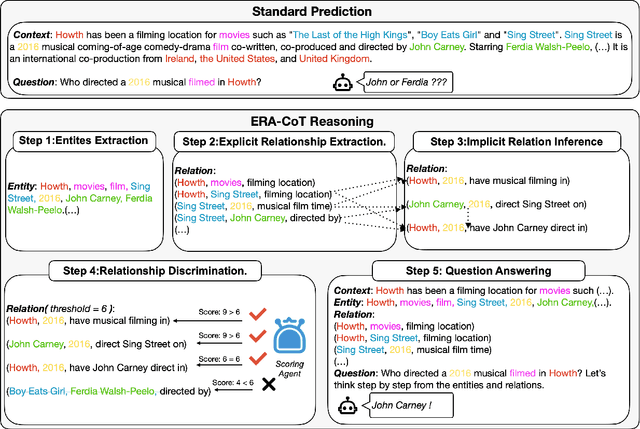
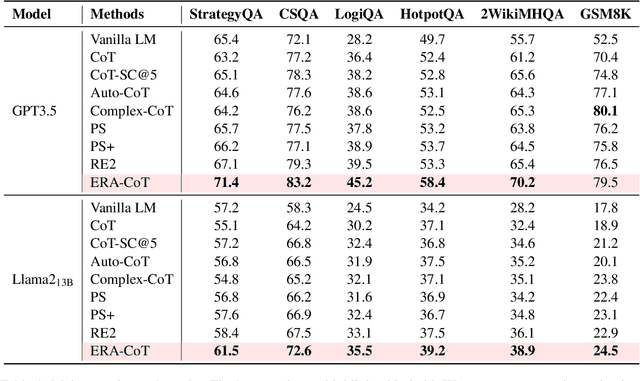
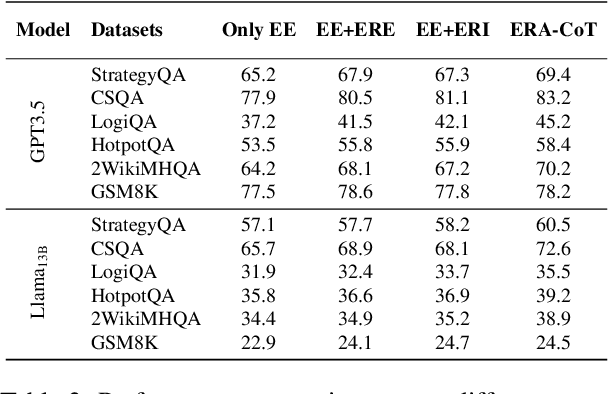
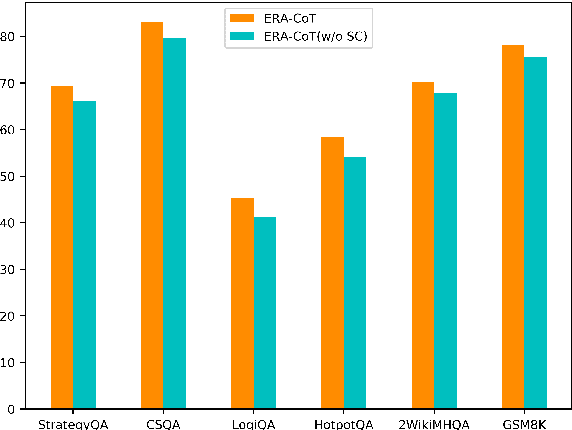
Abstract:Large language models (LLMs) have achieved commendable accomplishments in various natural language processing tasks. However, LLMs still encounter significant challenges when dealing with complex scenarios involving multiple entities. These challenges arise from the presence of implicit relationships that demand multi-step reasoning. In this paper, we propose a novel approach ERA-CoT, which aids LLMs in understanding context by capturing relationships between entities and supports the reasoning of diverse tasks through Chain-of-Thoughts (CoT). Experimental results show that ERA-CoT demonstrates the superior performance of our proposed method compared to current CoT prompting methods, achieving a significant improvement of an average of 5.1\% on GPT3.5 compared to previous SOTA baselines. Our analysis indicates that ERA-CoT increases the LLM's understanding of entity relationships, significantly improves the accuracy of question answering, and enhances the reasoning ability of LLMs.
SPA: Towards A Computational Friendly Cloud-Base and On-Devices Collaboration Seq2seq Personalized Generation
Mar 11, 2024Abstract:Large language models(LLMs) have shown its outperforming ability on various tasks and question answering. However, LLMs require high computation cost and large memory cost. At the same time, LLMs may cause privacy leakage when training or prediction procedure contains sensitive information. In this paper, we propose SPA(Side Plugin Adaption), a lightweight architecture for fast on-devices inference and privacy retaining on the constraints of strict on-devices computation and memory constraints. Compared with other on-devices seq2seq generation, SPA could make a fast and stable inference on low-resource constraints, allowing it to obtain cost effiency. Our method establish an interaction between a pretrained LLMs on-cloud and additive parameters on-devices, which could provide the knowledge on both pretrained LLMs and private personal feature.Further more, SPA provides a framework to keep feature-base parameters on private guaranteed but low computational devices while leave the parameters containing general information on the high computational devices.
RA-ISF: Learning to Answer and Understand from Retrieval Augmentation via Iterative Self-Feedback
Mar 11, 2024Abstract:Large language models (LLMs) demonstrate exceptional performance in numerous tasks but still heavily rely on knowledge stored in their parameters. Moreover, updating this knowledge incurs high training costs. Retrieval-augmented generation (RAG) methods address this issue by integrating external knowledge. The model can answer questions it couldn't previously by retrieving knowledge relevant to the query. This approach improves performance in certain scenarios for specific tasks. However, if irrelevant texts are retrieved, it may impair model performance. In this paper, we propose Retrieval Augmented Iterative Self-Feedback (RA-ISF), a framework that iteratively decomposes tasks and processes them in three submodules to enhance the model's problem-solving capabilities. Experiments show that our method outperforms existing benchmarks, performing well on models like GPT3.5, Llama2, significantly enhancing factual reasoning capabilities and reducing hallucinations.
 Add to Chrome
Add to Chrome Add to Firefox
Add to Firefox Add to Edge
Add to Edge